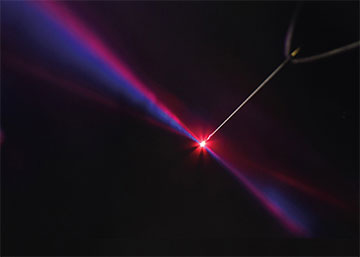
The rate of electron emission from a metal tip was measured with attosecond accuracy by recording the energy spectra of photoelectrons when a strong laser pulse (red) and a weaker second harmonic (blue) were focused onto its apex. [Image: FAU/T. Boolakee, P. Dienstbier]
Physicists in Germany have for the first time controlled and measured the light-induced emission of electrons from a metal surface with attosecond precision (Nature, doi: 10.1038/s41586-023-05839-6). The team believes that the laser-based technique will offer new insights into the quantum mechanical processes underpinning the photoelectric effect while also aiding the development of a new generation of ultrafast electronic circuits that are controlled by light.
Superimposing two pulses
Researchers have shown in recent years that intense pulses of laser light can be used to capture the electron dynamics in gases with attosecond accuracy, but these techniques cannot be applied to metals and other solid materials. The trick deployed in the latest work superimposed two laser pulses with different strengths and frequencies: a strong laser pulse stimulated the release of electrons from a metallic tip, while a weaker one at double the frequency modified both the probability of electron release and the energy of the emitted electrons.
In the experiment, the two-color laser field was tightly focused onto the apex of a metallic needle. The researchers recorded the energy spectra of electrons emitted from the tip as the phase difference between the two pulses was varied, from which they could determine the intensity and duration of electron emission with a precision of 30 attoseconds.
Electron emission from a metal surface
The results from the technique, called two-color modulation spectroscopy, offer new insights into the timing of electron emission from the metallic surface, as well as the subsequent movement of the electrons in the laser field. “This enables new quantum mechanical insights into both the emission from the solid-state body and the light fields used,” commented lead author Philip Dienstbier.
The team’s analysis shows that most of the electrons are emitted over a time window of 710 attoseconds, suggesting that light-controlled electronic circuits have the potential to operate in the petahertz regime. Modulating the phase difference between the two pulses also provides active control of the photoemission, offering a way to define a sequence of electrical pulses in these emerging light-wave devices.
“In the foreseeable future, it will be possible to integrate the components of our test setup—light sources, metal tip, electron detector—into a microchip,” added Dienstbier. Other applications include nanoplasmonics, where the method would provide a sensitive probe of ultrafast electron emission and near-field dynamics, and understanding the fundamental quantum mechanical processes at play in techniques such as time-resolved microscopy.
